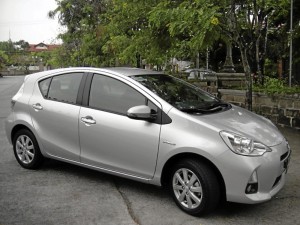When Toyota Motor Corp. introduced the Prius, the first gasoline-electric hybrid car for the mass market in 1997, the auto industry doubted that it would sell. Aside from its high price, it was derided for taking the fun out of driving because it wasn’t fast or sporty. Some car enthusiasts even depicted Prius owners as boring wimps.
But after 2.5 million Prius cars were sold worldwide, hybrid critics weren’t laughing anymore. Toyota is now into the third-generation Prius and early this year unveiled the Prius C, a hatchback that is the smallest, least expensive and sportiest in its hybrid line-up. The Prius C looks like a hybrid version of the Toyota Yaris subcompact as indeed it is built on a modified Yaris platform.
The Prius C has been described as a hybrid for people who don’t want the social stigma associated with owning a hybrid. Nineteen inches shorter and 500 pounds lighter than the original Prius liftback, the C uses a 73 hp 1.5 liter, 4-cylinder, 16-valve VVT-i DOHC engine which, when combined with the 60 hp electric motor, produces 99 net horsepower while max torque is 82 lb-ft. Last January 20, Toyota Motor Philippines (TMP) launched the Prius C in Manila as an “Eco Fun” car with Hybrid Synergy Drive that shifts between the electric motor and gasoline engine for excellent fuel economy (21 km per liter average in combined city and highway driving), reduced emissions and optimum performance (Toyota claims zero to 100 kph in 11.5 seconds, top speed 168 kph.)
Gall
I was able to check out these stats when TMP lent me a top-of-the-line, full-option White Pearl Prius C recently. On a traffic-free highway, the C, doing 175 kph, had the gall to overtake a 2.5 liter, turbocharged SUV which, provoked, tailgated me and then revved its 230 horses full throttle to speed away, leaving the humbled hybrid far behind. This experience reminded me that the “C” in Prius C means “city,” meaning that the baby hybrid is mainly designed for placid urban driving. TMP claims that C also means Compact, Clean and Clever, all of which proved to be true.
While the C is not that dynamic, its smaller, livelier chassis, reduced weight (the sealed nickel metal hydride battery pack with 120 cells weighs only 68 lbs) and the technical aspects of Hybrid Synergy Drive translate into agile handling and nimbleness around town. The turning radius is a tight 15.7 feet. Unlike the full-size Prius, the C drives like a normal car using rack and pinion Electric Power Steering, standard gear and a Start/Stop push button. The transmission is an electronically controlled CVT with ECO and EV mode settings driving the front wheels.
The hydraulic regenerative brakes (ventilated discs in front and drums at the rear) constantly recharge the battery while the car is being driven, eliminating the need to plug it into a charger. When the C is fully stopped, both the gas engine and electric motor switch off to reduce wasted fuel while idling. The trapezoidal shape design of the C and the tapering rear deck hint at aerodynamic performance and provide 0.28 coefficient of drag. The suspension system consists of Macpherson strut type with stabilizer in front and torsion beam at the rear.
Full option
In the full-option variants, the seats are leather with the driver seat 6-way adjustable and the front passenger seat 4-way while the rear seat is 60/40 split folding. The digital meter gauge is positioned at center and a 3.5-inch full-color TFT [Thin Film Transistor] multi-info display helps the driver use the hybrid features and monitor actual fuel savings. The aircon is fully automatic with air filter and the audio system has six speakers, a CD player, tuner, Bluetooth with AUX and USB input.
All the above are standard equipment in the full-option variants and show that the Prius C is more substantially kitted than an entry-level subcompact although it is the smallest and least costly in Toyota’s hybrid stable. The neat, well-organized operating system and utility functions were designed for the comfort of daily driving. Moreover, the C contains a complete suite of active and passive safety features: Vehicle Stability Control with traction control, Hill Start Assist, SRS airbags for the driver, front passenger, driver’s knee and curtain shield, ABS with Brake Assist, touch sensor type Wireless Door Lock with smart entry and anti-theft system with immobilizer. The only thing lacking is a rear-view camera for easier parking and backing up maneuvers since the Prius C has thick C pillars that obstruct the driver’s view of what’s behind.
Bottom line, the Prius C offers effortless fuel efficiency and Eco Fun in an attractive, sporty-looking small hatchback package. The price tag may be higher (P1,435,000 for the standard, P1,490,000 for the standard White Pearl, P1,525,000 for the full option, P1,540,000 for the full option White Pearl) than an internal combustion-engined subcompact, but it feels good to know that your ride is spewing less toxic emissions and getting 21 km per liter every day even when the price of gasoline reaches P60 per liter.
